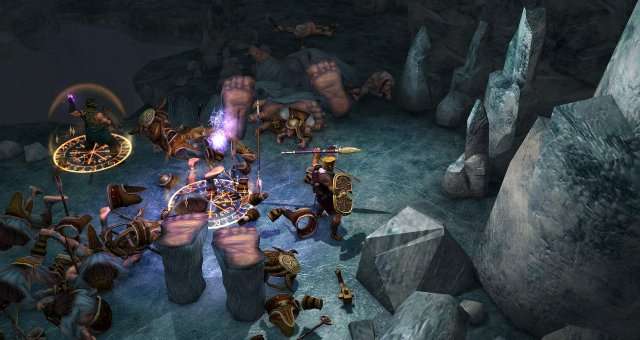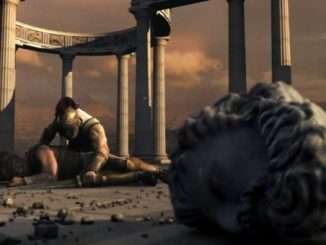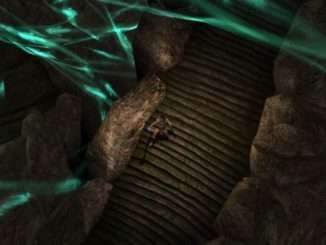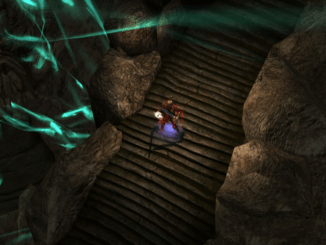
This is a compilation of all kinds of information regarding damage in Titan Quest AE. This is a dense guide not friendly to the eye.
In-Depth Damage Mechanics Guide
This is a compilation of all kind of information regarding damage in Titan Quest AE. I will try to arrange it as coherent as possible.
All this knowledge has been tested over and over on version 2.9 of the Anniversary game (the latest version at the time I upload this document), tweaking weapons and monsters, resistances, health pools.
All damage mechanics are usually applied the same way in both ways: player damaging monster, and monster damaging player.
Displayed Damage
With the option “All Damage” selected in the game preferences, really all the damage shown on screen is the damage done to the monster. There’s no “hidden” damage I know about.
All instant damage is aggregated in one single damage number, color varies depending on damage majority, white is physical, pink is elemental, critical hits done by weapon damage will be always yellow, with different font size, regardless of the damage type.
Example: you do 50 physical + 200 fire, shows 250 pink. You do 60 physical as a critical of 1.2, plus the 200 fire, the value shown is 260 as yellow with the bigger font and all that.
All damage over time is aggregated in another single damage number, is always a pale orange color, the counter shown goes on if you reapply a DoT up to a few seconds after the displayed damage fades off.
Damage Over Time Specifics
- Tests are done mainly with poison and bleeding, but should apply to all kinds of damage over time.
- Poison duration bonus does not affect poison DPS. +100% duration of 100 poison over 3 secs is 200 poison over 6 secs as result.
- Envenomed weapons augments (percent poison damage, extended duration) regardless of the tooltip, works on poison from any source.
- DoT application, the damage in application, and the duration is remembered individually, it doesn’t refresh previous applications, however, for any number of applications from the same source, only the highest damage will be in effect.
- In other words, If you re-apply poison from the same source with a different magnitude, the highest magnitude will be used against the monster until that application ends, each magnitude on application and its duration is tracked individually.
This is a bit complex so here’s an example:
- You attack with your poisoned weapon, a chance for extra poison damage triggers, applies 100 poison damage over 10 seconds, then after 5 seconds of damage (50 damage done), you attack again with the poisoned weapon, dealing only 10 poison damage over 10 seconds. From that point, will deal 50 poison damage during 5 seconds, then 5 poison damage during the next 5 seconds. This is useful with chance of total damage, debuff skills, burst damage from lethal strike…
About Physical Damage
- Weapon damage base cannot be augmented before damage calculations in any way. Bonus damage or physical damage on a weapon or a charm/relic in that weapon are considered separate sources of (non-weapon) damage. This is important because weapon damage has superior damage scaling from strength, and is the only source that can be converted and can crit (melee only) anything else is considered non-weapon damage.
- Bonus damage on weapon is special. Doesn’t scale with percent physical damage, strength, or criticals, doesn’t get converted to elemental with transmutation, doesn’t get converted by weapon’s pierce ratio, is always considered physical damage, so is mitigated by physical resistance and physical absorption, but ignores armor.
- Extra damage from weapon strength formula (IE 10 damage with 250 strength) doesn’t scale with percent physical, is added to the weapon damage against armor.
- Every other source of physical damage will be considered as an independent source of non-weapon damage, scales with percent physical. IE: Physical damage from weapon affixes, rings, equipment, relics, artifacts, skills.
- On strength scaling: Weapon damage doubles at 500 strength and gets 20 extra damage. Non-weapon damage doubles at 650 strength. Each 100 strength means 15% extra non-weapon damage and 20% weapon damage plus 4 damage.
- Physical percent and Total damage percent from any source is added altogether and act multiplicatively regarding strength damage boost.
- Each source of physical damage will deal with armor independently. This means if you attack a monster with 100 armor with your weapon with a raptor tooth (physical damage charm) and a physical damage ring, using the Shield bash skill, the weapon damage, the damage from the charm, the damage from the ring, and the damage from the skill will deal with that 100 armor independently.
- On monster damage, first, the damage is reduced by resistances, then armor absorption is applied. So if you do 200 Phys damage and the monster has 50% Phys resist, 100 remaining damage will be checked against armor.
Weapon Damage Conversions
- Elemental conversion mainly from the rune skill, is applied before any calculation, having a 100 Phys damage base weapon with 50% conversion is exactly the same as a 50 Phys damage base weapon with a 50 elemental damage affix.
- Pierce damage derivated from pierce ratio conversion on weapon is obtained from weapon physical damage after physical percent, strength, and crit are applied in the damage calculation, but before any mitigation from the target resistance/armor. Then the pierce percent and strength/dexterity formula for pierce ratio damage are applied.
- The pierce weapon damage formula is a complex one, strength lowers the multiplier, dexterity rises it, however, the extra pierce from strength from the previous calculation outweighs the loss in this formula. Even so, dexterity will give more pierce damage than strength applied in the two steps.
The exact formula is:
- (((pierceDamage % ((strength % 500) + 1)) x ((strength % 2000) + 1)) x ((dexterity % 400) + 1)) + (dexterity x 0.03)
If you do 50 weapon damage with 500 strength and +100% physical damage, the damage we are going to split for pierce ratio would be 220:
- (50 x 2 (percent phys) x 2 (str)) + 20 (str).
From this 220 physical damage, let’s say we have a 50% pierce ratio: 110 damage will remain physical and will go against resistances and armor, the other 110 damage is base pierce damage.
If we have also +100% pierce, and 500 dexterity:
- (110 weapon pierce x 2 (percent pierce) x 1.55 (dex/str formula)) + 15 (dex/str formula) = 356 pierce damage.
This damage goes against pierce resist/absorb.
Physical Resistance, Resistance Reduction and Armor
Physical Resistance directly mitigates/augment all the incoming physical damage by a set percent: IE you do 200 physical damage (after all physical damage calculations, modifiers, strength, etc), the target has 20% physical resistance. Then your damage is 200 x (1 – 0.20) = 200 x 0.8 = 160 physical damage.
Armor cover a range of physical damage and mitigates 66% of that damage before resistance modification. This effect is called armor absorption.
From the example from before, we have 160 physical damage, the target also has 100 armor. 100 of our damage is 66% absorbed, the 60 remaining goes straight to the health pool.
So: (100 x (1 – 0.66)) + 60 = 34 + 60 = 94 final damage.
If the damage is lower than the armor all the damage is reduced by 66%. So if the target had 200 armor instead, vs the 160 damage.
(160 x (1 – 0.66)) = 54 final damage.
“-x% physical damage resistance”, found on a few skills (Battle Standard – Triumph on warfare, Study prey on Hunting), is also applied before damage.
So if we do again 200 damage, and we place a battle standard with -50% physical damage resistance, the monster again has 20% physical resistance.
First, the monster resistance becomes -30% physical resistance due to the battle standard.
So: 200 x (1 – (-0.30)) = 200 x 1.3 = 260 damage. This value goes against armor.
“x% reduced resistances” and “-x reduced resistances”, are duration effects applied on hit (very similar to Poison, Bleeding), and doesn’t count in the damage done with the hit that applies them. They affect all resistances and armor.
As an example, Squall is a spell that hits every second during its duration (6 seconds). Obscured visibility adds a debuff that applies “x% reduced resistances” debuff over 6 seconds. So the first hit of squall won’t benefit from the reduced resistances, but the effect will persist for 5 seconds more than squall duration if the monsters are hit with the last hit.
The same rule applies to affixes with these effects on weapons and gear/jewelry. On the first hit with the weapon (or a weapon skills, like dual-wield skills, shield skills, whirlwind, take down…), the debuff is applied, following hits will benefit of the reduced resistances while the debuff persists and is re-applied.
Example: Monster has 20% physical res and 200 armor.
We hit him with “-50 reduced resistances for 3 seconds”: for 3 seconds, Monster has now -30% physical res and 150 armor.
We hit him with “50% reduced resistances for 3 seconds”: for 3 seconds, Monster has now 10% physical res and 100 armor.
TL DR, everything stack as long as comes from different sources, except X% reduced resistances, always uses only the greatest reduction value. -X% resistance only appear on some sort of debuff auras, usually from skills, the other two are debuff effects themselves.
Dual Wield
All double weapon skills attack with both weapons to each target, each attack is separate (you will see two numbers) and deal with armor independently.
Reckless offense rune DW skill: with melee weapons attack four times, two with each weapon. With throwing weapons are three attacks, left, right, left always (is character’s left hand, on equip screen is the one most at the right of the character window).
Attack Speed
Unarmed always is 100% attack speed base, affected directly by attack speed percent, multiplicatively.
The character has 75% base attack speed, weapons have a value that is added to this base speed.
Staves always add 10%, Bows 5% or 10%, Spears 10% or 15%, Maces/clubs 15%, 20% and 25%, Axes 30% or 35%, Sword 40%, 45% and 50%.
The tags Slow, Average, Fast, Very fast are assigned to weapons manually, there are some mistakes, but 95% of the time:
Very Slow 5% and 10%, Slow 15% and 20%, Average 25%, 30% and 35%, Fast 40% and 45%, Very fast 50%
One weapon, Two hands weapon, Weapon and shield: 15% reduction to base speed (character + weapon), multiplicatively.
Dual wield: Averages both weapons’ speed. Adds extra 10% reduction to the one weapon attack speed, multiplicatively. ((character + weapon) x 0.85) x 0.9
Attack speed percent from weapons and items are added all together and affect the result also multiplicatively.
You have a 50% dagger and a 30% club and you dual wield. You also have +50% attack speed from equipment.
Your base is 75% + ((50% + 30%) % 2) = 75% + 40% = 115% base.
Then we apply the 15% reduction and the 10% extra reduction from dual wielding: (115% x (1 – 0.15)) x (1 – 0.10) = 115% x 0.85 x 0.9 = 88%
Then we apply the +50% attack speed: 88% x 1.50 = 132% This is the final speed shown on the character screen.
As a curiosity, if we divide 100 by our final attack speed shows up how frequently we launch an attack again. 100 % 132 = Every 0.76 seconds (normal speed).





Be the first to comment